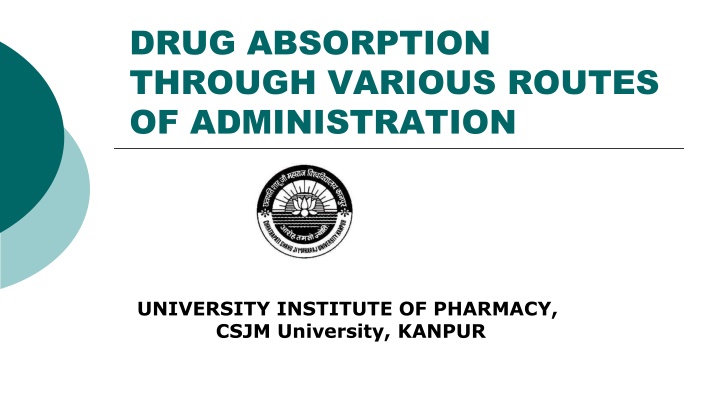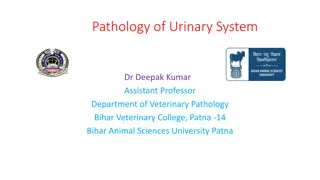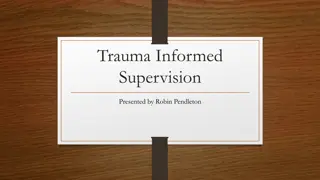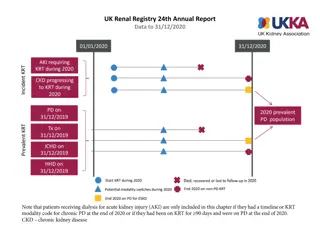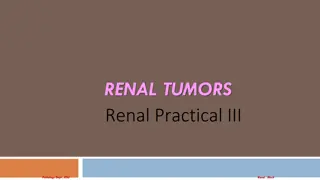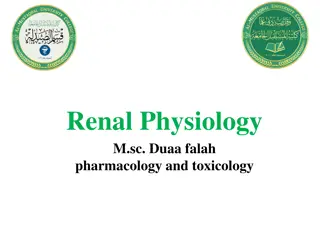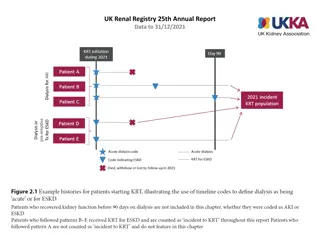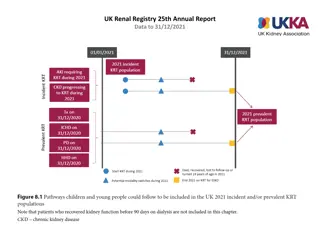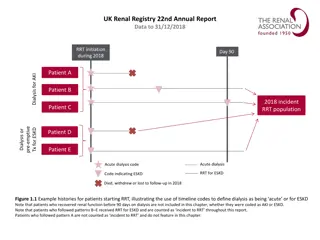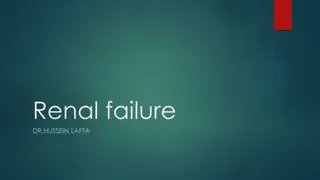Renal Trauma: Causes and Classification
Renal trauma, a common result of blunt or penetrating injuries, can lead to various levels of kidney damage. Blunt trauma, high-speed collisions, and penetrating injuries can cause different grades of renal damage, ranging from minor contusions to severe vascular injuries. Prompt recognition and appropriate management are crucial in treating renal trauma.
Download Presentation

Please find below an Image/Link to download the presentation.
The content on the website is provided AS IS for your information and personal use only. It may not be sold, licensed, or shared on other websites without obtaining consent from the author.If you encounter any issues during the download, it is possible that the publisher has removed the file from their server.
You are allowed to download the files provided on this website for personal or commercial use, subject to the condition that they are used lawfully. All files are the property of their respective owners.
The content on the website is provided AS IS for your information and personal use only. It may not be sold, licensed, or shared on other websites without obtaining consent from the author.
E N D
Presentation Transcript
DRUG ABSORPTION THROUGH VARIOUS ROUTES OF ADMINISTRATION UNIVERSITY INSTITUTE OF PHARMACY, CSJM University, KANPUR
Absorption from the gastrointestinal tract (GIT) is governed by factors such as: Surface area for absorption Blood flow to the site of absorption The physical state of the drug (solution, suspension, or solid dosage form), Its water solubility, and Concentration at the site of absorption. Drugs given orally may be inactive systemically because of: Enzymatic degradation of polypeptides within the lumen of the GI tract e.g. insulin, adrenocorticotropic hormone (ACTH). Poor absorption from the GI tract e.g. aminoglycoside antibiotics; or Inactivation by first pass metabolism. 2
For drugs given in solid form, the rate of dissolution may be the limiting factor in their absorption Most drug absorption from the GI tract occurs by passive diffusion, absorption is favored when the drug is in the nonionized and more lipophilic form The epithelium of the stomach is lined with a thick mucous layer, and its surface area is small; by contrast, the villi of the upper intestine provide an extremely large surface area (~200 m2). Rate of absorption of a drug from the intestine will be greater than that from the stomach even if the drug is predominantly ionized in the intestine and largely non ionized in the stomach Any factor that accelerates gastric emptying will be likely to increase the rate of drug absorption whereas any factor that delays gastric emptying is expected to have the opposite effect Drugs that are destroyed by gastric secretions or that cause gastric irritation sometimes are administered in dosage for with an enteric coating. 3
Controlled-Release Preparations A slow rate of dissolution of a drug in GI fluids is the basis for: 1. controlled-release 2. Extended release 3. sustained-release, and prolonged-action preparations Are designed to produce slow, uniform absorption of the drug for 8 hours or longer. Such preparations are offered for medications in all major drug categories. 4
SUBLINGUAL ADMINISTRATION Venous drainage from the mouth is to the superior vena cava, which protects highly soluble drugs like nitroglycerin from rapid hepatic first-pass metabolism. If a tablet of nitroglycerin were swallowed, the accompanying hepatic metabolism would be sufficient to prevent the appearance of any active nitroglycerin in the systemic circulation. RECTAL ADMINISTRATION The rectal route, though less predictable, can be used when oral ingestion is excluded because the patient is unconscious or when vomiting is present. Major portion of the drug that is absorbed from the rectum will bypass the liver, thus reducing the hepatic first-pass effect. 5
TRANSDERMAL ABSORPTION Absorption of drugs able to penetrate the intact skin is dependent on the surface area over which they are applied and their lipid solubility. The dermis is freely permeable to many solutes; consequently, systemic absorption of drugs occurs much more readily through inflamed, abraded, burned, or denuded skin. Unwanted effects can be produced by absorption through the skin of highly lipid-soluble substances (e.g. a lipid-soluble insecticide in an organic solvent). Transdermal absorption can be enhanced by suspending the drug in an oily vehicle and rubbing the resulting preparation in to the skin. Hydration of the skin with an occlusive dressing may facilitate absorption. Transdermal patches of nitroglycerine, fentanyl, nicotine and estradiol are available in India, while those of isosorbide dinitrate, hyoscine, and clonidine are available in other countries. 6
PARENTERAL INJECTION A. Intravenous Bioavailability is rapid and complete(100%). No absorption is needed. Also, drug delivery is controlled and give immediate effect. Irritating solutions can be given only in this manner because the drug, if injected slowly, is greatly diluted by the blood. Another reason for this is absence of sensory reception in blood vessels Eg. Chemotherapy drugs like cisplatin, paclitaxel etc. Occasionally, a drug is injected directly into an artery to localize its effect(intraarterial administration) Diagnostic agents sometimes are administered by this route (e.g., technetium labelled human serum albumin) 7
B. SUBCUTANEOUS Used only for drugs that are not irritating to tissue; otherwise, severe pain, necrosis occurs. The rate of absorption often is sufficiently constant and slow to provide a prolonged effect. Moreover, altering the period over which a drug is absorbed may be varied intentionally, as is accomplished with insulin for injection using particle size, protein complexation, and pH. Absorption of drugs implanted under the skin in a solid pellet form occurs slowly over a period of weeks or months; some hormones (e.g. contraceptives) are administered effectively in this manner. 8
C. INTRAMUSCULAR Drugs in aqueous solution are absorbed rapidly after intramuscular injection depending on the rate of blood flow to the injection site and the fat versus muscular composition of the site. Absorption may be modulated to some extent by local heating, massage, or exercise. Generally, the rate of absorption following injection of an aqueous preparation into the deltoid or vastus lateralis is faster than when the injection is made into the gluteus maximus. The rate is particularly slower for females after injection in to the gluteus maximus, due to low muscle to fat ratio. Slow, constant absorption from the intramuscular site results if the drug is injected in solution, oil, or various other repository(depot) vehicles. 9
D. INTRATHECAL The blood brain barrier and the blood cerebro spinal fluid (CSF) barrier often preclude or slow the entrance of drugs into the CNS. Therefore, when local and rapid effects on the meninges or cerebro spinal axis are desired, drugs sometimes are injected directly into the spinal subarachnoid space. Brain tumors may be treated by direct intraventricular drug administration. E. PULMONARY ABSORPTION Gaseous and volatile drugs may be inhaled and absorbed through the pulmonary epithelium and mucous membranes of the respiratory tract. Access to the circulation is rapid by this route because the lung s surface area is large (~140m2) and first-pass metabolism is avoided. The principles governing absorption and excretion of anesthetic and other therapeutic gases. 10
F. TOPICAL APPLICATION 1. Mucous Membranes Drugs are applied to the mucous membranes of the conjunctiva, nasopharynx, oropharynx, vagina, colon, urethra, and urinary bladder primarily for their local effects. 2. Eye Topically applied ophthalmic drugs are used for their local effects requiring absorption of the drug through the cornea; corneal infection or trauma thus may result in more rapid absorption. Ophthalmic delivery systems that provide prolonged duration of action (e.g. suspensions and ointments) are useful, as are ocular inserts providing continuous delivery of drug. 11
References Biopharmaceutics and pharmacokinetics A Treatise, D.M. Brahmankar, Sunil B. Jaiswal, 1995 edition, Vallabh Prakashan, page no. 5-75. Pharmacology and Pharmacotherapeutics, R.S. Satoskar, Nirmala N. Rege, S.D. Bhandarkar, 24nd edition 2015, Popular Prakashan, page no. 14-19. Goodman & Gillman s The Pharmacological basis of therapeutics, Laurence L. Brunton, Randa Hilal-Dandan, Bjorn C. Knollmann, 13th edition, McGraw hill publishers, page no 13-18. Essentials of Medical Pharmacology, KD Tripathi, 7th edition 2013, Jaypee Brothers Medical Publishers (P) ltd., page no. 10-17. 13 Special Thanks to Sudhanshu Sahu, M.Pharm. (Pharmacology) Scholar of CSJM University
